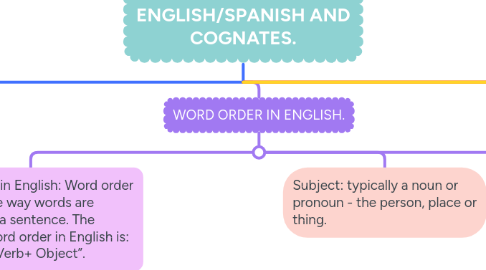
1. WORD ORDER IN SPANISH.
1.1. Por lo general, el español presenta la información discursiva con el siguiente orden de palabras: sujeto (S), verbo (V) y objeto (o).
1.1.1. Se reconoce un tipo de orden natural y otro invertido:
1.1.1.1. Orden sintactico.
1.1.1.1.1. La construcción sintáctica es la que ordena los elementos de la frase según su función gramatical:
1.1.1.1.2. Sujeto
1.1.2. Orden natural: Sujeto-Verbo-Objeto-Complementos adverbiales.
1.1.2.1. Orden invertido: Complementos adverbiales-Sujeto-Verbo-Objeto.
2. WORD ORDER IN ENGLISH.
2.1. Word order in English: Word order refers to the way words are arranged in a sentence. The standard word order in English is: “Subject + Verb+ Object”.
2.1.1. Word order structures: When we talk about someone receiving something, we can express it using the typical word order:
2.1.1.1. If we want to bring more emphasis or focus to the recipient, we can use a prepositional complement (pc) instead of an indirect object.
2.1.1.1.1. Adjectives often come before the noun.
2.1.2. “Indirect object (io) + direct object (do)”.
2.2. Subject: typically a noun or pronoun - the person, place or thing.
2.3. Verb: The action or state of being.
2.3.1. Object: The word or group of words influenced by the verb
3. COGNATES.
3.1. Perfect cognates: as words that are spelt exactly the same in Spanish and English except for maybe an accent over one letter and they mean the same thing in both languages.
3.1.1. False cognates: they are words that are spelt the same or similar but mean completely different things
3.1.1.1. Considerations about cognates and false cognates
3.1.1.2. False cognates should be taught in the beginner levels in order to avoid future confusions and embarrassments.
3.1.1.2.1. To avoid confusing these words give words within a context.
4. Examples of False Cognates.
4.1. And finally, we have the false cognates in Spanish, which are deceptive for appearing to be the same, but have unexpectedly different meanings.
4.1.1. The list includes the Spanish translation of the English word and examples of the false cognates. Then, you will find the English translation of the cognates words in Spanish and an example sentence using the term. Be sure to listen to the audio so that you can hear the difference in pronunciation as well!
4.1.1.1. Actual — actual English word: Actual Spanish translation: Exacto, real The actual translation is different. La traducción exacta es diferente. Spanish word: Actual English translation: Current Este es mi número actual. This is my current number.
4.1.1.1.1. Pie — pie English word: Pie Spanish translation: Pay This lemon pie is delicious. Este pay de limón está delicioso. Spanish word: Pie English translation: Foot Me duele el pie derecho. My right foot is hurting.
5. Examples of True Cognate.
5.1. A true cognate or easy cognate is a word that is “either spelled the same or similar and often sounds alike in both languages.” In other words, it’s near-perfect but not identical.
5.1.1. Think of “action” in English and acción in Spanish.
5.1.1.1. Both words have similar sound and spelling and they (generally) have the same meaning (acción does mean “action,” but it can also mean “stock” or “share” in financial terms).
5.1.1.1.1. Both words have similar sound and spelling and they (generally) have the same meaning (acción does mean “action,” but it can also mean “stock” or “share” in financial terms).
6. Example of perfect Cognate.
6.1. When the meaning, spelling, and sound is identical, as in animal and (el) animal, they’re known as perfect cognates in Spanish. The only difference is in pronunciation.
6.1.1. Other examples include: (el) chocolate (el) doctor (el) error.
